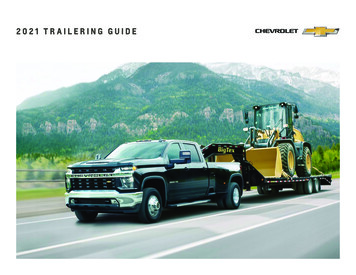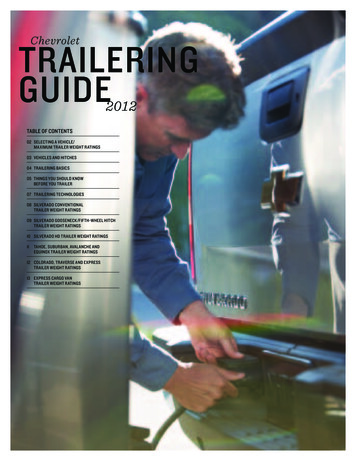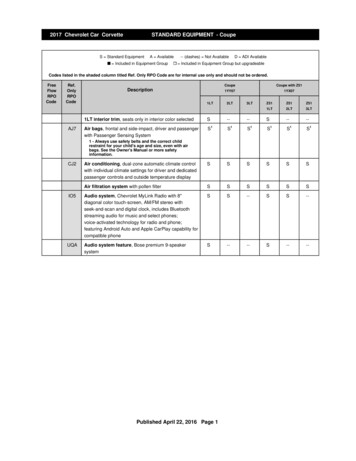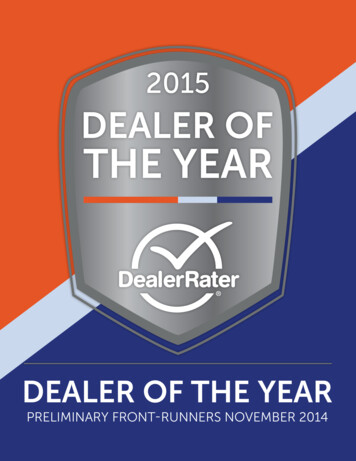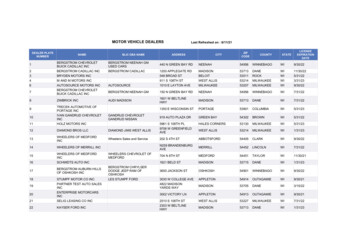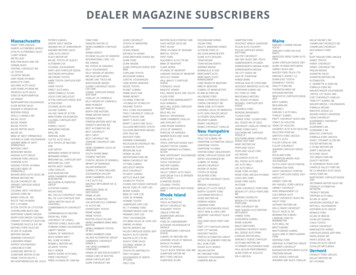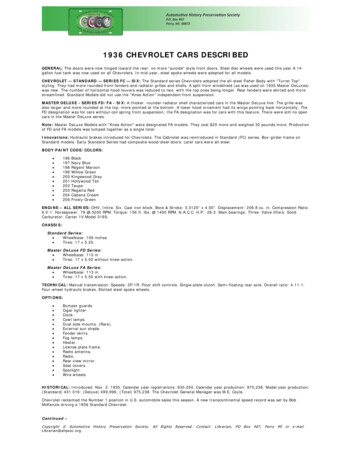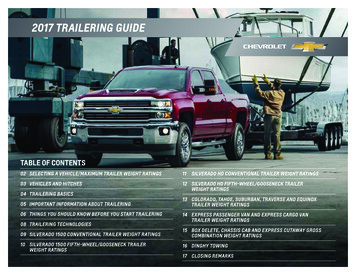
Transcription
2017 TRAILERING GUIDETABLE OF CONTENTS02 SELECTING A VEHICLE/MAXIMUM TRAILER WEIGHT RATINGS1103 VEHICLES AND HITCHES12 SILVERADO HD FIFTH-WHEEL/GOOSENECK TRAILERWEIGHT RATINGS04 TRAILERING BASICS05 IMPORTANT INFORMATION ABOUT TRAILERING06 THINGS YOU SHOULD KNOW BEFORE YOU START TRAILERING08 TRAILERING TECHNOLOGIESSILVERADO HD CONVENTIONAL TRAILER WEIGHT RATINGS13 COLORADO, TAHOE, SUBURBAN, TRAVERSE AND EQUINOXTRAILER WEIGHT RATINGS14 EXPRESS PASSENGER VAN AND EXPRESS CARGO VANTRAILER WEIGHT RATINGS09 SILVERADO 1500 CONVENTIONAL TRAILER WEIGHT RATINGS15 BOX DELETE, CHASSIS CAB AND EXPRESS CUTAWAY GROSSCOMBINATION WEIGHT RATINGS10 SILVERADO 1500 FIFTH-WHEEL/GOOSENECK TRAILERWEIGHT RATINGS16 DINGHY TOWING17 CLOSING REMARKS
02 SELECTING A VEHICLE/MAXIMUM TRAILER WEIGHT RATINGS (LBS.)1The chart below gives you an idea of the maximum amount of weight you can confidently and safely trailer with different Chevrolet models when your vehicle is properly equipped.When determining the total weight of trailer and cargo, include the weight of any additional passengers and optional equipment (driver weight and base equipment are already included).EquinoxTraverseLow Cab press 3500 Passenger Van9,60010,00012,500Silverado 2500HDSilverado 3500HD1 Before you buy a vehicle or use it for trailering, carefully review the Trailering section of the Owner’s Manual. The weight of passengers, cargo and options or accessories may reduce the amount you can ,600Silverado 150011,0003,500Express 2500 Passenger VanExpress 2500/3500 Cargo ,0000See pages 09–15 for maximum trailer weight ratings by specific model.
03 VEHICLES AND HITCHESHitch Ball on Step-BumperFifth-Wheel HitchHitch Ball on Draw BarGooseneck HitchWeight-Distributing Hitch with Sway ControlSELECTING THE RIGHT HITCH Choosing the right hitch andgooseneck hitches are most frequently used with traveltrailering application. The weight of any additional equipmentmaking the proper electrical connections affects how yourtrailers, horse trailers and other large trailers.and all passengers other than the driver must be subtractedfrom the payload weight to determine the maximum kingpinvehicle handles, corners and brakes, and allows you to alertother drivers of your intentions. Before selecting a hitch orHITCHES It’s important to have the correct hitch equipment.load availabletrailering package, you should be familiar with the weightratings specific to your Chevrolet vehicle, which are detailed onpages 09–13. If you’ll be towing a trailer that requires a weight- distributingWIRING HARNESS This allows you to connect the electricalhitch, be sure to use a frame-mounted, weight-distributingcomponents of your trailer, such as turn signals and brakehitch1 and sway control of the proper sizelights, to the trailering vehicle. Select Silverado models and allSELECTING TRAILERING EQUIPMENT Most Chevrolet vehiclesoffer a variety of standard and available equipment forSuburban and Tahoe models feature a seven-pin wiring harness If you have to make any holes in the body of your vehicleto streamline hookup of trailer lighting and brakes, and aenhanced trailering performance. Aside from the equipmentto install a trailer hitch, be sure to seal the holes if youbussed electrical center makes it easier to connect thedescribed below, features such as heavy-duty cooling andever remove the hitch. If they’re not sealed, dirt, waterintegrated trailer brake controller.extendable trailering mirrors may be available. See yourand deadly carbon monoxide from the exhaust can getChevrolet dealer for more information on the model you’reinto your vehicleweight on Silverado, Tahoe and Suburban, and above a 1,000-lb.interested in.WEIGHT-CARRYING HITCH This consists of a hitch ball mountedFIFTH-WHEEL TRAILERING Some Silverado models can betrailer weight on all other models. (Brake requirements vary byequipped with a fifth-wheel or gooseneck trailer hitch.State, consult State laws for actual requirements.) The mostcommon trailer braking systems are surge brakes (foundto a step-bumper or draw bar. Hitch balls are available in arange of sizes. Make sure that the diameter of your hitch ballTRAILER BRAKES These are required above a 2,000-lb. trailer Follow the manufacturer’s directions for installation, but noteprimarily on boat trailers) and electric brakes (often used onmatches your trailer coupler. Also check that the ball meets orthat the hitch must be attached to the truck frame. Do not usetravel trailers, horse trailers and car haulers). Surge brakes areexceeds the gross trailer weight rating.the pickup bed for additional support. For proper kingpina self-contained hydraulic brake system on the trailer,tongue load distribution and control of the trailer, the hitchactivated during deceleration as the trailer coupler pushes onWEIGHT-DISTRIBUTING HITCH This hitch type distributes themust be mounted so the kingpin load is placed (over or slightly)the hitch ball. An electric trailer brake system uses a braketrailer tongue load by using spring bars to shift some of theahead of the rear axle centerlinecontrol unit mounted inside the trailering vehicle; it operates bysensing the vehicle brakes and then applying the trailer brakes.hitch weight forward onto the tow vehicle’s front axle andrearward to the trailer’s axles.FIFTH-WHEEL HITCH AND GOOSENECK HITCH These are Fifth-wheel trailer kingpin loads are higher than conventionaltrailer tongue loads, so pay careful attention to the truck’sSILVERADO SERIES In general, a higher series number in apayload capacity and rear axle weight ratingsmodel indicates a greater load-carrying capacity. In addition, atruck with a higher series number typically has a strongerdesigned for heavy trailering. Located in the bed of the truck,these hitches position the trailer’s kingpin weight over, orslightly in front of, the truck’s rear axle. Fifth-wheel and1 Not required on Silverado 2500HD or 3500HD. Your Chevrolet dealer can help you calculate the maximumallowable payload and GVWR required for your fifth-wheelframe, stiffer suspension and higher-capacity brakes,increasing the truck’s ability to trailer heavy loads.
04 TRAILERING BASICSTowing a trailer involves all major vehicle systems of yourRGAWR AND GVWR Addition of trailer hitch weight cannotAXLE RATIO In general, a higher axle ratio offers higher TrailerChevrolet vehicle. Easy and safe trailering requires a properlycause vehicle weights to exceed Rear Gross Axle Weight RatingWeight Ratings, quicker acceleration and less fuel efficiency.equipped vehicle, additional trailering equipment and an(RGAWR) or Gross Vehicle Weight Rating (GVWR). These ratingsA lower axle ratio offers more fuel efficiency and quieter vehicleappropriate trailer. It also requires loading both the vehicle andcan be found on the certification label located on the driver dooroperation but will have slower acceleration and lower Trailertrailer properly, using safe driving techniques, meeting regionalor doorframe.Weight Ratings.schedules. The vehicle owner is responsible for obtaining theGCWR The Gross Combination Weight Rating is the totalNOTE The safety steps described here are by no means the onlyproper equipment (hitch ball, hitch type of the proper size andallowable weight of the completely loaded vehicle and trailer.precautions to be taken when trailering. See the Owner’slegal requirements, and following break-in and maintenancecapacity) required to safely tow both the trailer and the loadManual for your Chevrolet vehicle for additional guidelines andthat will be towed. For more information, consult your Owner’sTRAILER WEIGHT RATING This rating is determined byManual or speak to a trailering expert at your Chevrolet dealer.subtracting the tow vehicle’s weight (curb weight) from theThese charts will assist in determining how to best equip yourGross Combination Weight Rating (GCWR). Base vehicle (curb)TRAILERING CAUTION If you don’t use the correct equipmentChevrolet vehicle for trailering. To help you understand theweight plus driver is used, so additional passengers, equipmentand drive properly, you can lose control of your vehicle whencharts, consider these trailering factors:and cargo weight reduce this rating.you pull a trailer. If the trailer is too heavy, your vehicle brakestrailering tips.may be less effective. You and your passengers could beseriously injured. Pull a trailer only after you have read theinformation in this guide and followed the steps on thefollowing pages.TRAILER CLASSIFICATIONTYPICAL EXAMPLESTYPICAL GROSS TRAILER WEIGHT EXAMPLESTYPICAL HITCH TYPE1Light-Duty (I)Folding camping trailer, snowmobiles and personal watercraft trailers (trailer and cargo combined)Up to 2,000 lbs. gross trailer weightWeight-carrying hitchMedium-Duty (II)Single-axle trailers up to 18 ft., open utility trailers and small speedboats2,001–3,500 lbs. gross trailer weightWeight-carrying hitchHeavy-Duty (III)Dual- or single-axle trailers, larger boats and enclosed utility trailers3,501–5,000 lbs. gross trailer weightWeight-carrying hitch2 or weight-distributing hitchExtra Heavy-Duty (IV)Two-horse, travel and fifth-wheel recreational trailers5,001–10,000 lbs. gross trailer weightWeight-carrying hitch,2 weight-distributing hitch,2 fifth-wheel hitch orgooseneck hitchMaximum Heavy-Duty (V)Largest horse, travel and fifth-wheel recreational or commercial trailers10,001 lbs.-and-above gross trailer weightWeight-carrying hitch,2 weight-distributing hitch,2 fifth-wheel hitch orgooseneck hitch1 Represents minimum recommended hitches. Please refer to your trailer’s Owner’s Manual or ask your Chevrolet dealer. 2 Not required on Silverado 2500HD or 3500HD.
05 IMPORTANT INFORMATION ABOUT TRAILERINGThe information below is intended to give you someBecause the trailer weight rating is calculated for a line ofThe tongue weight for your trailer is the downward force ofdetails about the trailer ratings on your vehicle and avehicles, rather than an individual load situation, somethe coupler of the trailer on the vehicle hitch. You can calculateway to ensure that the vehicle you use can handle thestandardized assumptions are made when calculating thethe tongue weight by placing the tongue of the trailer on anload you want to pull.trailer weight rating. First, the base curb weight of that typeappropriate scale. For conventional trailering, the tongueof vehicle is used (the weight of a standard equipped vehicleweight should be 10% to 15% of the loaded trailer weight. ForTRAILER WEIGHT RATINGS AND GROSS COMBINATIONwithout any options). Second, it is assumed that there is onlyfifth-wheel/gooseneck trailering, the tongue weight shouldWEIGHT RATINGS Chevrolet engineers perform extensivea driver and also a front passenger each weighing 150 lbs.be a minimum of 15% of the loaded trailer weight.testing of acceleration, handling, braking, and thermal andThird, it is assumed there is a certain tongue weight for thestructural performance to determine the Gross Combinationload (a tongue weight is the weight of only the tongue of theThe GVWR is the maximum amount the vehicle itself shouldWeight Rating (GCWR) and the trailer weight rating for yourloaded trailer). For conventional trailering, a tongue weightweigh, including the as-equipped weight of the vehicle plus thevehicle. The GCWR is the total allowable weight of thethat is 10% of the loaded trailer weight is used. For fifth-wheel/cargo, passengers and trailer tongue weight. Put another way,completely loaded vehicle and trailer including anygooseneck trailering, a tongue weight that is a minimum of 15%the GVWR should always be greater than or equal to the weightpassengers, cargo, equipment and conversions. You shouldof the loaded trailer weight is used.of your vehicle, passengers, cargo and tongue weight.not exceed the GCWR of your vehicle when you tow a trailer.HOW TO KEEP YOUR LOAD WITHIN THE CAPABILITIES OFChevrolet also calculates and publishes a trailer weight ratingYOUR VEHICLE It is important that the combination of thefor each model or series of Chevrolet vehicles for comparisontow vehicle and trailer does not exceed any of its weightpurposes. The trailer weight rating is not specific to anratings — GCWR, GVWR, RGAWR, trailer weight rating orindividual vehicle and is most useful for comparing producttongue weight. The only way to be sure to not exceed anylines to one another to help you select a product that will meetof these ratings is to weigh the tow vehicle and traileryour needs. When you buy a vehicle, you should ensure thatcombination, fully loaded for the trip, getting individualthe total load (including passengers, cargo and equipment)weights for each of these items. You can then subtract theyou intend to pull with it will be less than the trailer weightweight of your vehicle from the GCWR. The differencerating of the vehicle.between the two is the capacity you have available for yourcargo, passengers, trailer, load and any other equipment youmight use to set up your trailer. Put another way, your GCWRshould always be greater than or equal to the weight of yourvehicle, passengers, cargo, trailer (with equipment) and load.
06 THINGS YOU SHOULD KNOW BEFORE YOU START TRAILERINGBEFORE YOU TRAILERaccelerator. Allow your vehicle to safely reach a comfortablesoft shoulders, curbs, trees or other objects when making tightdriving speed. Give yourself extra time and room when mergingturns. Taking turns sharply can also cause the trailer to strikeSAFETY CHAINS Always attach safety chains between youronto highways. Braking when pulling a trailer requires extraagainst and damage the tow vehicle. When approaching avehicle and your trailer and cross them under the tongue of thedistance. Allow ample room to come to a safe stop. A goodsharp corner, brake sooner than normal to reduce vehicletrailer so that the tongue will be less likely to drop if the trailermeasure for determining a safe following distance is to allowspeed before entering the turn. Drive the vehicle slightly pastshould separate from the hitch. Leave enough slack in theone vehicle and trailer length between you and the vehiclethe normal turning point then firmly turn the steering wheel.chains so you can corner without the chains impeding theahead of you for every 10 mph of speed. When braking, useBy cornering at a wider angle, both the vehicle and trailermovement of the trailer. Do not allow safety chains to dragfirm, steady pressure on the brake pedal.should safely clear the inside of the turn.CONTROLLING TRAILER SWAY Sway refers to instability ofPASSING When passing, allow additional time and distance toLOADING YOUR TRAILER Load your trailer to attain a 10%–15%the trailer relative to the tow vehicle, and often results fromsafely pass the other vehicle. Signal your intention to pass welltongue weight. Some specific trailer types (especially boatimproper weight distribution, excessive speed or overloading.in advance and, when reentering the lane after passing, maketrailers) fall outside of this range. In these cases, theOther factors that can cause sway are crosswinds, poor vehiclecertain your trailer is clear of the vehicle you have passed.recommended tongue weight listed in the trailer Owner’smaintenance and road conditions. Trying to steer out of swayNever pass on hills or around curves.Manual should be observed. A good rule of thumb is towill likely make it worse. Speed is a major contributor to trailerdistribute 60% of the load over the front half of the trailersway, so you need to slow the vehicle — braking, however, couldBACKING UP To back up a trailer, place one hand at the sixand evenly from side to side. Loads sitting either too farlead to a jackknife or other loss of control.o’clock position on the steering wheel. To move the trailer toon the ground.forward or too far back in the trailer can create unstabletrailering conditions — such as trailer sway — at highwayTO CONTROL SWAYthe left, move your hand to the left. To move the trailer to theright, move your hand to the right. Back up slowly and move thesteering wheel in small increments to help maintain control.speeds and during heavy braking. Once the trailer has beenloaded and the weight is distributed properly, all cargo should Hold the steering wheel as steady as possibleTo assist in backing up, it is helpful to have someone outsidebe secured to prevent the load from shifting. Release the accelerator but do not touch the brake pedalthe vehicle to guide you. Make certain you can see your spotter Activate electric trailer brakes (if equipped) by hand, until theat all times.SAFETY CHECKLIST Before starting out on a trip, doublecheck the hitch and platform, the hitch nuts and bolts, mirrorsway condition stops Use the vehicle brakes to come to a complete stopDRIVING ON GRADES Before going down a steep grade, reduceyour speed and shift the transmission into a lower gear. Thisadjustments, safety chains, and vehicle and trailer lights.Make sure that a sway-control device is installed, if required,You should then pull your vehicle to the side of the road andprovides “engine braking” and reduces the need to brake forand that the device is working properly (see charts on pagesattempt to determine the cause of the instability. Check thelong periods. Chevrolet crossover, SUV and pickup models09–14). Check tire pressure on both the tow vehicle and thecargo load for shifting and improper weight distribution.equipped with a 6-speed automatic transmission, as well astrailer. If your trailer has electric brakes, test them by manuallyCheck tire pressure on the tow vehicle and trailer and thepickups equipped with the available 8-speed automatic haveengaging the brake controller while the vehicle is movingcondition of the suspension and shocks. If the sway wasa grade braking feature in the transmission which can do thisslowly. Check to see that the breakaway switch, if available,caused by strong winds, wait for conditions to improve beforefor you. See your dealer or Owner’s Manual for additionalis connected and functioning properly. Finally, make certaincontinuing your trip.information. When driving up a steep incline, shift to a lower gearfor more torque to maintain speed and avoid lugging. Luggingthat all loads are secure.ON THE ROADFinally, some trailers can be equipped with anti-sway devices.occurs when the vehicle’s engine stutters because it needs to beContact the manufacturer of your trailer for availability.in a lower gear. Crest the hill no faster than the speed at whichyou want to descend and in the gear you expect will require littleACCELERATING/BRAKING Avoid overworking your engineCORNERING The turning radius of a trailer is typically muchbraking. Pay attention to your temperature gauges for any signswhen trailering by applying gradual pressure on thesmaller than that of your vehicle; therefore, a trailer may hitof overheating.
07 THINGS YOU SHOULD KNOW BEFORE YOU START TRAILERING (CONTINUED)OVERHEATING Prolonged driving with overheated fluids can With the vehicle in Park or Neutral, the parking brake engaged,cause damage to your vehicle. If temperature gauges registerand being mindful of traffic, exit your vehicle and look forabnormally high, if there is a marked decrease in power or ifsteam or leaking coolant underneath the engine.you hear unusual engine noises, immediately take theIf you see either of these, shut off the engine and allow thefollowing steps:engine to cool. To avoid being burned, do not attempt toLEAVING YOUR PARKING SPOT ON GRADES Hold the brake pedal down and start the engine Shift into gear and release the parking brakeremove the radiator cap until the engine has cooled Pull your vehicle to the side of the road. Once stopped, shift Release brake and drive uphill slightly until freeinto Park (automatic transmissions) or Neutral (manualPARKING ON GRADES Parking on steep grades with a trailertransmissions) and apply the parking brakes. Leave theis not recommended; if you must, follow this procedure:engine running Apply brakes and have someone retrieve the blocks Apply the brakes and shift into Neutral Turn off air conditioning and other accessories to reduceload on the engine. Roll down the windows and turn the heateron to maximum and the fan to its highest setting. The heater Have someone place trailer wheel blocks on thedowngrade sidecore provides a second cooling surface that can help reduceengine temperatures If you suspect that the overheating is the result of climbing along, steep grade, run the engine at fast idle (around 1500 rpm)until the temperature gauge registers a normal readingfrom the blocks Release the brakes until the blocks absorb the load Apply the parking brake and shift into Park
08 TRAILERING TECHNOLOGIESTRAILERING PACKAGE An optional Heavy-Duty TraileringINTEGRATED TRAILER BRAKE CONTROLLER This is optionalCRUISE GRADE BRAKING Included with the 6-speed andEquipment Package is available for a wide variety of Chevroleton Silverado, Colorado, Suburban and Tahoe. Completely8-speed automatic transmission on Silverado, the cruise grademodels. The Z82 Package includes a trailer hitch platform andintegrated within the electrical system, antilock brakingbraking feature automatically downshifts to help slow themay include other trailering equipment.system and StabiliTrak, it allows your trailer’s brakes totruck and preserve your brake pads on long, steep descents.operate simultaneously with the vehicle’s brakes.TRAILER SWAY CONTROL Working in conjunction with theEXHAUST BRAKE SYSTEM The diesel brake system onStabiliTrak Electronic Stability Control System and integratedREAR VISION CAMERA This available feature is designedSilverado HD works with the available Allison transmissiontrailer brake controller (if equipped), the Trailer Sway Controlto allow the driver to use the radio screen (if equipped) or theand the Tow/Haul mode and auto grade braking features.feature on Silverado, Suburban and Tahoe senses trailerrearview mirror to see certain stationary obstacles locatedAfter adjusting for the load and grade, a variable vanesway and automatically applies the vehicle and trailer brakesbehind the vehicle when traveling in reverse at low speeds.geometry turbo creates back pressure to slow the vehicleand reduces engine power, if necessary, to help you get backThis feature is especially helpful when backing up to hitchand help reduce brake use. That means reduced brake fade,on track.your trailer.prolonged brake life and more confidence when you’re pulling23,200 lbs.,3 especially on steep grades, increasing theHILL START ASSIST On inclines greater than a 5% grade,TRAILERING CAMERA SYSTEM This system, available fromvehicle’s ability to trailer heavy loads. An exhaust brakeHill Start Assist on Silverado, Suburban, Tahoe, Traverse andChevrolet Accessories, includes two side view mirror camerassystem is also included on Colorado models with the availableEquinox automatically engages to hold the vehicle stationarythat provide a wide 70-degree viewing angle to help eliminateDuramax 2.8L Turbo-Diesel 4-cylinder engine.for about a second, allowing the driver time to press theblind spots and a rear trailer camera that produces a behindaccelerator before the vehicle can roll backward. It can betrailer view when backing up. Two other cameras are available:AUTOMATIC LOCKING REAR DIFFERENTIAL This GM-exclusiveextremely helpful when you’re stopped on a steep grade witha wireless camera that can be mounted inside the trailerfeature sends maximum drive power to the wheel with grip ina vehicle two feet from your rear bumper. The availableto let you keep an eye on important cargo such as horseslow-speed situations when rear-wheel slippage happens.integrated trailer brake controller will also assist with thisor livestock, and a Center Brake Light Camera that’sAvailable on Colorado, Express, Silverado, Silverado HD, Tahoefeature and apply the trailer brakes.instrumental in monitoring cargo bed contents or liningand Suburban models.up your fifth-wheel or gooseneck hitch.STABILITRAK ELECTRONIC STABILITY CONTROL StabiliTrakEXTENDABLE TRAILERING MIRRORS These vertical manual-helps improve vehicle stability, particularly during emergencyTOW/HAUL MODE Standard Tow/Haul mode on Express,folding and extendable mirrors have 50 square inches of flatmaneuvers. The StabiliTrak control module compares yourSilverado, Silverado HD, Suburban and Tahoe as well asmirror surface and 20 square inches of convex mirror surfacesteering input with the vehicle’s actual response and then, ifavailable Tow/Haul mode on Colorado and Traverse adjuststo help you see what’s happening around you. They arenecessary, makes small, individual brake and engine torquethe shift schedule in the automatic transmission so it isn’tavailable as a factory option on Silverado and Silverado HD orapplications to enhance control and help you keep on track.“hunting” for the correct gear while towing or trailering.as a dealer-installed Chevy Accessory.AUTO GRADE BRAKING Standard on Silverado, Suburban andMAX TRAILERING PACKAGE Available on Silverado 1500, TahoeTahoe, this feature works with the cruise control to maintainand Suburban, the Max Trailering Package offers increasedvehicle speed on long, steep grades.towing capability over the standard trailering package. See12StabiliTrak automatically intervenes when it senses loss oflateral traction.dealer for details.1 With available 3.6L V6 engine or Duramax 2.8L Turbo-Diesel 4-cylinder engine. 2 With available Tow Package. 3 Requires Silverado 3500HD Regular Cab 4x4 DRW model with available Duramax 6.6L Turbo-Diesel V8 engine and fifth-wheel hitch. Before you buy a vehicle or use it fortrailering, carefully review the Trailering section of the Owner’s Manual. The weight of passengers, cargo and options or accessories may reduce the amount you can tow.
09 SILVERADO 1500 CONVENTIONAL TRAILER WEIGHT RATINGSThese charts specify the trailer weight rating for your vehicle equipped with a conventional hitch. The maximum rating for a weight-carrying hitch is listed in the General Trailering Notes below.Do not exceed the trailer weight rating.1 For more information, ask your Chevrolet dealer.SILVERADO 1500 CONVENTIONAL TRAILER WEIGHT RATINGS 1ENGINEEcoTec3 4.3L V6AXLE RATIO3.23GCWR 2 STANDARD BOX 2WD11,0006,000REGULAR CABLONG BOX STANDARD BOX2WD4x45,900—LONG BOX4x4—4-DOOR DOUBLE CABSTANDARD BOX STANDARD BOX2WD4x45,600—SHORT BOX2WD5,500CREW CABSTANDARD BOX SHORT BOX2WD4x4——STANDARD 009,3009,1009,100EcoTec3 5.3L V8 withMax Trailering 00010,80010,800EcoTec3 5.3L V8 (8-speed 1009,100EcoTec3 5.3L V8 (8-speed automatic)with Max Trailering 80010,700EcoTec3 6.2L ��——EcoTec3 5.3L V8EcoTec3 6.2L V8 withMax Trailering Package3.4217,70018,200————GENERAL TRAILERING NOTES Where available, the Heavy-TRAILER TONGUE WEIGHT NOTES Trailer tongue weightDuty Trailering Equipment Package (Z82) provides a trailershould be 10% to 15% of total loaded trailer weight up tohitch platform and 7-pin and 4-pin sealed connectors at the1,250 lbs. The addition of trailer tongue weight must notrear bumper.cause vehicle to exceed Rear Gross Axle Weight Rating(RGAWR) or Gross Vehicle Weight Rating (GVWR).1 Before you buy a vehicle or use it for trailering, carefully review the Trailering section of the Owner’s Manual. The weight of passengers, cargo and options or accessories may reduce the amount you can tow. 2 Gross Combination Weight Rating.
10 SILVERADO 1500 FIFTH-WHEEL/GOOSENECK TRAILER WEIGHT RATINGSThese charts specify the trailer weight rating for your vehicle equipped with a fifth-wheel or gooseneck trailer. The maximum rating for a weight-carrying hitch is listed in the General TraileringNotes below. Do not exceed the trailer weight rating.1 For more information, ask your Chevrolet dealer.SILVERADO 1500 FIFTH-WHEEL/GOOSENECK TRAILER WEIGHT RATINGS 1ENGINEEcoTec3 4.3L V6AXLE RATIO3.23GCWR 2 STANDARD BOX 2WD11,0006,000REGULAR CABLONG BOX STANDARD BOX2WD4x45,900—LONG BOX4x4—4-DOOR DOUBLE CABSTANDARD BOX STANDARD BOX2WD4x45,600SHORT BOX2WD——CREW CABSTANDARD BOX SHORT BOX2WD4x4——STANDARD ��8,100EcoTec3 5.3L V8 withMax Trailering —10,700EcoTec3 5.3L V8EcoTec3 5.3L V8 (8-speed ,300EcoTec3 5.3L V8 (8-speed automatic)with Max Trailering 700EcoTec3 6.2L ,30011,700—EcoTec3 6.2L V8 withMax Trailering Package3.4217,70018,200————GENERAL TRAILERING NOTES Where available, the Heavy-FIFTH-WHEEL/GOOSENECK TRAILERING NOTES Silverado HDDuty Trailering Equipment Package (Z82) provides a trailercan be equipped with a fifth-wheel or gooseneck trailer hitch.hitch platform and 7-pin and 4-pin sealed connectors at theFollow the manufacturer’s directions for installation, but noterear bumper.that the hitch must be attached to the truck frame. Do not use—10,600——8,20010,500—the pickup bed for additional support. For proper kingpinFIFTH-WHEEL/GOOSENECK KINGPIN WEIGHT NOTEStongue load distribution and control of the trailer, the hitchFifth-wheel or gooseneck kingpin weight should be 15% of totalmust be mounted so the kingpin load is placed (over orloaded trailer weight. The additio
Extra Heavy-Duty (IV) Two-horse, travel and fifth-wheel recreational trailers 5,001-10,000 lbs. gross trailer weight Weight-carrying hitch,2 weight-distributing hitch,2 fifth-wheel hitch or gooseneck hitch Maximum Heavy-Duty (V) Largest horse, travel and fifth-wheel recreational or commercial trailers 10,001 lbs.-and-above gross trailer weight
